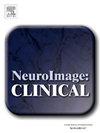网络靶向经颅磁刺激(TMS)治疗轻度认知障碍
IF 3.6
2区 医学
Q2 NEUROIMAGING
引用次数: 0
摘要
经颅磁刺激(TMS)是一种治疗轻度认知障碍(MCI)和早期阿尔茨海默病(AD)的有前途的非药物干预手段。然而,我们对刺激在哪些地方最适合改善认知功能知之甚少。目的探讨前额叶和顶叶刺激部位的网络功能连通性(fc)特征,这些部位在MCI-AD和未受损受试者的TMS研究中导致认知功能改善。方法静息状态功能MRI数据来自正在进行的TMS试验的32名MCI参与者的基线访问,并用于计算基于先前TMS研究选择的前额叶和顶叶刺激位置的连通性。研究了TMS种子图与8个典型网络的空间重叠程度。在确定最有可能被TMS靶向的网络后,我们应用了可能提供更纯粹靶向的策略。最后,我们研究了网络连接与参与者行为特征的关系,因为经颅磁刺激治疗可能是个性化的。结果前额叶经颅磁刺激种子图谱主要与显著性网络重叠。前额叶部位也因其与ad易感的后扣带皮层(PCC)的反相关连通性而值得注意。顶叶TMS种子图显示了与PCC和其他默认网络区域的强正连通性。尽管如此,这个特殊的顶叶位置可能同时调节额-顶叶网络。改进网络定位和个性化经颅磁刺激的策略被报告为次要研究结果。结论本研究结果可用于网络靶向脑刺激治疗轻度认知损伤及早期AD治疗。TMS更高的精确度和个性化为MCI或轻度AD痴呆患者提供了更好的治疗效果。本文章由计算机程序翻译,如有差异,请以英文原文为准。
Network-targeted transcranial magnetic stimulation (TMS) for mild cognitive impairment (MCI)
Background
Transcranial magnetic stimulation (TMS) is a promising non-pharmacological intervention for treatment of mild cognitive impairment (MCI) and early Alzheimer’s disease (AD). Yet, we know little about precisely where stimulation would be ideal to improve cognitive function.
Objective
To examine the network functional connectivity (fc) characteristics of prefrontal and parietal stimulation sites, given that these sites have led to improved cognitive function in TMS studies involving MCI-AD and unimpaired participants.
Methods
Resting-state functional MRI data were acquired from 32 MCI participants at the baseline visit of an ongoing TMS trial and used to compute connectivity with prefrontal and parietal stimulation locations, selected on the basis of previous TMS studies. The TMS seed maps were examined for extent of spatial overlap with eight canonical networks. After identifying the network most likely to be targeted by TMS, we applied strategies that may provide purer targeting. Finally, we examined network connectivity in relation to participants’ behavioral characteristics because of the potential for TMS treatment to be personalized.
Results
The prefrontal TMS seed map overlapped primarily with the salience network. The prefrontal site is also notable for its anti-correlated connectivity with the AD-vulnerable posterior cingulate cortex (PCC). The parietal TMS seed map showed the expected strong positive connectivity with the PCC and other default network regions. Nonetheless, this particular parietal site may simultaneously modulate the fronto-parietal network. Strategies to improve network targeting and to personalize TMS are reported as secondary findings.
Conclusion
These results can be applied to network-targeted brain stimulation for MCI and early AD treatment. Greater precision and personalization of TMS offer the promise of achieving better outcomes for individuals with MCI or mild AD dementia.
求助全文
通过发布文献求助,成功后即可免费获取论文全文。
去求助
来源期刊

Neuroimage-Clinical
NEUROIMAGING-
CiteScore
7.50
自引率
4.80%
发文量
368
审稿时长
52 days
期刊介绍:
NeuroImage: Clinical, a journal of diseases, disorders and syndromes involving the Nervous System, provides a vehicle for communicating important advances in the study of abnormal structure-function relationships of the human nervous system based on imaging.
The focus of NeuroImage: Clinical is on defining changes to the brain associated with primary neurologic and psychiatric diseases and disorders of the nervous system as well as behavioral syndromes and developmental conditions. The main criterion for judging papers is the extent of scientific advancement in the understanding of the pathophysiologic mechanisms of diseases and disorders, in identification of functional models that link clinical signs and symptoms with brain function and in the creation of image based tools applicable to a broad range of clinical needs including diagnosis, monitoring and tracking of illness, predicting therapeutic response and development of new treatments. Papers dealing with structure and function in animal models will also be considered if they reveal mechanisms that can be readily translated to human conditions.
 求助内容:
求助内容: 应助结果提醒方式:
应助结果提醒方式:


